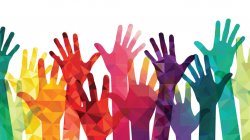[Milton A. Fuentes, Director of the Research Academy for University Learning, received his MA in Psychology with a concentration in Latino Mental Health from Montclair State University and his PsyD in clinical psychology from the Graduate School of Applied and Professional Psychology at Rutgers University. He completed a pre-doctoral fellowship in clinical and community psychology at Yale University and secured post-doctoral training in epidemiology at Columbia University. He is currently Professor of Psychology and Director of the Clinical and Community Studies Laboratory at Montclair State University; and a licensed psychologist in New Jersey and New York.]
Studies have shown that classrooms across the country are becoming more racially and ethnically diverse. Data on high school completers enrolled in 2- and 4-year colleges from 1960 through 2014 reveal substantial increases in Black and Latinx students (National Center for Education Statistics, 2015). Additionally, the Black student population has grown by 11%, while the Latinx population has grown by nearly 14%. Moreover, the Chronicle of Higher Education examined census data by county and state on potential students who are fourteen years away from being admitted into college and projected that the candidate pool will continue to be incredibly diverse. (Lipka, 2014).
What does this increased diversity signify for institutions of higher education? How do these numbers inform the diversity, inclusion, and equity conversations on campuses across the country? A quick keyword search for the term “diversity” in the Chronicle of Higher Education revealed 507 hits in this past year alone. And there are many concomitant difficulties. For example, the Boston Globe reported that in 2015 hundreds of students at Brandeis University occupied the administration building, demanding better management of bias concerns, more diverse faculty, and better trained as well as culturally-informed instructors. The Washington Post recounted how the Presidents of Ithaca College and the University of Missouri resigned due to the mishandling of racial incidents on their campuses (Svrluga, 2016). Climate surveys at two flagship universities, the University of Michigan at Ann Arbor and the University of Wisconsin at Madison, found that some students of color were less satisfied with the campus climate and/or felt less welcomed (Hoisington, 2017).
Diversity, inclusion, and equity conversations are varied and complex, but one theme central to this conversation, “implicit bias,” occurs when “traces of past experience affect some performance, even though the influential earlier experience is not remembered in the usual sense—that is, it is unavailable to self-report or introspection.” (Greenwald and Babaji, 1995, p. 4.)
These pernicious systemic dynamics make their way into our classrooms. Boysen and Vogel (2009) found that students often exhibit both explicit and implicit biases in their interactions with other students or faculty, and while faculty try to address them, they are not sure if their well-meaning efforts are successful. Likewise, faculty and administrators possess these biases.
As faculty, we must find ways to accept that we and our students are not immune to the implicit biases associated with race and ethnicity, and be willing to consider how these biases affect the teaching and learning process, including grading procedures, classroom norms, and teaching strategies. Devine et al. (2012) offer effective and straightforward strategies based upon sound social psychology research that will assist in managing these biases, including education and awareness building, stereotype replacement, counter-stereotypic imagining, individuation, perspective-taking, and contact.
Diversity comes with its challenges; however, I would be remiss if I ended this brief discussion without pointing out the many benefits associated with ethnically and racially diverse campuses. Some have argued that the presence of diversity on our campuses makes us smarter (Rodriguez 2014). Diverse students and faculty enrich the academic landscape with a multiplicity of culturally-informed worldviews that broaden and deepen our understanding of the areas under study in higher education. Our students benefit greatly, developing intercultural competencies that allow them to interact successfully with individuals different than they are, and that will serve them as well as they enter the 21st-century workforce.
My fervent hope is that institutions of higher education and their faculty will welcome the opportunities that diverse campuses offer, and embrace the openness, risk-taking, and courage needed to engage in sound teaching and learning practices. Montclair State University’s Research Academy for University Learning stands ready to support these efforts.
References
Boysen, G. A., & Vogel, D. L. (2009). Bias in the Classroom: Types, Frequencies, and Responses. Teaching Of Psychology, 36(1), 12-17.
Devine, P. G., Forscher, P. S., Austin, A. J., & Cox, W. T. (2012). Long-term reduction in implicit race bias: A prejudice habit-breaking intervention. Journal of Experimental Social Psychology, 48, 1267-1278. doi:10.1016/j.jesp.2012.06.003
Greenwald, A. G., & Banaji, M. R. (1995). Implicit social cognition: attitudes, self-esteem, and stereotypes. Psychological Review, (1), 4.
Hoisington, S. (2017, November 17). 2 Flagship Universities Surveyed the Campus Climate: Here’s What They Found. Chronicle of Higher Education. p. 1.
Lipka, S. (2014, January 24). Colleges, Here Is Your Future. Chronicle of Higher Education. A24-A27.
National Center for Education Statistics (2015). Percentage of recent high school completers enrolled in 2- and 4-year colleges, by race/ethnicity: 1960 through 2014. Retrieved from https://nces.ed.gov/programs/digest/d15/tables/dt15_302.20.asp
Rodriguez, G. (2014). How Immigrants and Diversity Make Us Smarter. Retrieved from http://time.com/2973809/immigration-diversity-smarter/
Ransom, J. (2015, November). Brandeis students say campus lacks racial diversity. The Boston Globe, November 22, 2015.
Svrluga, S. (2016, January). Ithaca College president resigns after protests over race issues. The Washington Post.

